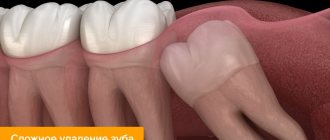The problem of bad breath plagues almost the entire population of the world. It is often quite simple to deal with it by brushing your teeth with a refreshing paste on your toothbrush. However, in some situations, if the smell thins out the aroma of rot, this is quite difficult to do. This disease is called halitosis, and by its nature it causes its owner not pain, but psychological problems, sometimes leading to depression.
That is why the putrid smell should be gotten rid of immediately in order to lead a normal personal life and good communication. To do this, the first thing you should do is find out the root cause of such an unpleasant odor and the possibility of curing it.
Sources of halitosis
The smell of rotten breath is a serious reason to visit the dentist.
itself is an unpleasant, persistent odor from the mouth that cannot be eliminated with home hygiene products.
This problem, in its essence, is not a disease at all, but simply helps a person understand that there are disorders in the body.
This is why the first thing a person should do is see a dentist, as the source can often be found in the oral area. Only after this, if the dentist is unable to detect it, does an examination of the internal organs begin.
Doctors include the most well-known sources of disgusting odor:
- problematic teeth - the presence of caries, inflammation of the gums and bone tissue, improper treatment when placing a filling, stomatitis;
- fungal infection or disturbances in the functioning of the salivary glands, especially in old age, when the flow of saliva becomes much less;
- diseases of internal organs - intestines, pulmonary and endocrine systems;
- The appearance of bad breath in women can provoke menstruation ;
- inflammation in the body .
What to do if a crown falls out -
The simplest option is when the crown falls out not because of carious destruction of the tooth tissue underneath, but because of poor cement fixation of the crown on the tooth. The main reasons for the loss in this case: mistakes by the dentist when fixing the crown with permanent cement, low clinical height of the crown (in this case, the crown will always fall out with regularity). In this case, it is enough to immediately contact your dentist to have a new crown fixed on your tooth.
1) What to do if a crown with a pin falls out -
Often, when preparing a tooth for prosthetics, a pin or stump inlay is fixed in the root canal. If your crown and pin fall out, this is again due to poor quality work by dentists. The fact is that severely damaged tooth crowns (before prosthetics with crowns) are restored by good dentists not with the help of pins, but with the help of stump inlays.
How a tooth is restored using a pin and filling -
Therefore, if the crown of your tooth was almost completely destroyed and it was restored with the help of filling material and a pin, the loss of the crown will be a pattern, because such a design is simply not able to withstand normal chewing pressure. By the way, no less often in such situations, the pins lead to a root fracture, after which the tooth is removed altogether.
If such a crown falls out, then the filling material with a pin sticking out of it remains inside the crown. Of course, it is possible to simply cement all this over again in the root canal (and we are sure that you will find dentists who will be ready to do this), but this is absolutely forbidden. Here you need to restore the tooth again - preferably with a stump tab, and then make a new crown. Otherwise, you will simply lose this tooth.
2) If the crown falls out along with the stump tab -
If a badly damaged tooth was restored not with a pin, but with a stump tab, the crown may also sometimes fall out.
This is usually also due to dentist mistakes. The fact is that after fixing the stump tab in the root canal, many dentists, saving time, begin to file it with burs within 15 minutes and take an impression. The fact is that after fixing the stump tab, a whole day must pass before you can begin to adjust it with a drill. If the adjustment is made 10-20 minutes after fixation, which some dentists like to do to save time, then vibration when processing the inlay with a drill will lead to partial destruction of the cement that has not yet fully hardened. This leads to the fact that after a week, a month or six months, the crown falls out along with the stump tab.
How a tooth is restored using a stump inlay -
What to do - unlike the situation when the tooth was restored with a filling and a pin - such a structure can still be re-fixed in the root canal (without the need to replace the crown), but only if you immediately contact the dentist.
The crown lies on the gum: what to do
Very often there are cases when inflammation of the gums begins around the artificial crown - as a result of which the gums swell, grow, and chronic inflammation is constantly maintained in this place. Most often, this is due to the fact that the crown injures the edge of the gum with its overhanging edges (which should not normally exist).
In some cases, the problem can be solved by surgical adjustment of the gingival margin, i.e. when part of the gum near the crown is removed. But according to the rules, the overhanging edge of the crown, which injures the gingival margin, is a warranty case, and you have the right to demand a replacement of the crown (if the warranty period has not yet expired, which is usually 1 year). We hope that our article was useful to you!
Sources:
1. Personal experience as a dentist, 2. “Orthopedic dentistry. Textbook" (Trezubov V.N.), 3. "Orthopedic treatment with fixed prostheses" (Rozenshtil S.F.).
Causes of unpleasant odor
The source of halitosis can be not only dental problems, but also diseases of internal organs.
In general, all the causes of the unpleasant smell of rotten breath can be divided into 2 large groups:
- physiological stem from poor diet and terrible oral hygiene;
- Pathological causes are influenced by more serious problems with internal organs and dental diseases.
| Reason for the smell | Main features | Associated symptoms |
| Disorders in the gastrointestinal tract | With increased acidity in the stomach, ulcers and gastritis, sour breath occurs. Dysbacteriosis and intestinal obstruction – heavy aroma of feces. In case of low acidity or poisoning - hydrogen sulfide. | The most common symptoms are nausea and vomiting. There is a constant bitterness in the mouth. Constipation, diarrhea and stomach pain are characteristic of gastrointestinal diseases |
| Respiratory diseases | Smells like rot and pus | Severe shortness of breath, sometimes turning into suffocation, cough: dry or wet depending on the illness, coughing up blood |
| Severe caries in an advanced stage | Rotten smell of rotten meat | Acute but short-term pain with shooting, brown spots on the teeth |
| Presence of dentures in the mouth | Putrid aroma | A large number of bacteria accumulate on dentures |
| Diseases of the ENT system | The odor usually resembles that of pus, but depending on the disease, it may be stronger. | Immune system disorders, inflammation in damaged areas, high body temperature, discharge from the ears and nose, pain |
| Constant smoking | The aroma of rot and the specific aroma of tobacco | Dry mouth, gray skin |
| Disorders of the salivary glands | Fetid smell of rot | Dry mouth due to low saliva production, shooting pain in damaged saliva and swelling |
| Diabetes mellitus type 1 and 2 | Unpleasant smell of acetone and fruits | Constant fatigue, frequent urination, constant hunger and thirst, numbness in the arms and legs |
| Liver failure | Smells like rotten fish and ammonia | Bitterness in the mouth, nausea, jaundice, muscle weakness, shortness of breath |
| Periodontitis | Sulfur scent | Food getting between the teeth, feeling of their unsteadiness, discomfort when chewing, formation of pockets in the gums |
Putrid breath in children and adolescents
If your child has bad breath, pay attention to the accompanying symptoms.
Children may experience bad breath due to many reasons. It can affect anyone, from infants to teenagers. The main factor is almost always the increased proliferation of bacteria and other pathogenic microbes in the tongue area or on the tonsils.
Serious internal diseases at this age develop quite rarely, so the first thing you should pay attention to is oral hygiene and the balance of microflora.
- The first thing you should pay attention to is saliva. Often there may be severe dryness in the mouth, which leads to the appearance of aroma. It occurs due to a chronic runny nose, growths on the tonsils, or frequent mouth breathing, especially during sleep.
- The second most likely factor is the appearance of caries and the development of other dental diseases; this issue is especially relevant in adolescents when wisdom teeth begin to appear, and in infants during the teething period, accompanied by inflammation.
- The appearance of diseases of the gastrointestinal tract.
In any case, if bad breath appears, parents should take the child for a comprehensive examination to identify the root cause and timely treatment.
Crown loss
The cause of crown loss may be carious destruction of tooth tissue or poor cement fixation. It is necessary to contact a dentist to re-fix the product on the unit.
Loss of the structure with the pin is also a fairly common problem, occurring due to the low competence of doctors. Severely damaged units should be restored using stumps rather than pins. When faced with such a dental problem, the doctor must restore the damaged tooth using a stump inlay and install a new crown. Otherwise, there is a risk of losing the unit.
Less often, dentists are faced with situations where fillings with core inlays fall out. If you contact the clinic in a timely manner, such structures are re-fixed in the root canal and do not require replacement of the prosthesis.
What to do if the crown lies on the gum
Some patients complain of redness, swelling and chronic inflammation of the gums. This is due to injury to the mucous membrane by the sharp overhanging edges of the prosthetic product. The solution to the problem is surgical correction of the gingival margin - removal of part of the gum tissue adjacent to the artificial element.
Patients should be aware that, in accordance with the rules, an overhanging edge of the prosthesis that damages adjacent tissues is a warranty case. Dental clients have the right to demand a crown replacement if the warranty period has not yet expired.
Ways to combat bad breath
Since this dental problem is caused by suppuration, it is impossible to get rid of the symptom on your own. The following recommendations will help reduce negative manifestations during the treatment period:
- Mouth rinses. Special antiseptic solutions are used as recommended by the dentist. You can use decoctions of chamomile, oak and forest herbs.
- Professional cleaning of teeth and dentures.
- Compliance with the rules of daily oral hygiene. It is recommended to use not only toothpaste and a brush, but also additional devices: irrigator, floss, dental floss.
The doctor develops a therapeutic program based on the data obtained during the diagnosis. He is faced with the task of stopping the inflammatory process and preserving the element. The following methods are used:
- Cleaning and reinstallation of the prosthetic device. Used in mild clinical situations.
- Installation of a new prosthesis. When the old structure becomes loose or falls out.
- Implantation and prosthetics. Used in advanced stages of pathology.
If you follow medical recommendations, problems with bad breath will no longer bother the patient.
Diagnosis
For self-diagnosis, use dental floss.
It is quite easy to determine whether a person has a problem with bad breath, even at home. Objectively, it is best to use another person for this, who will tell you the result.
You can use dental floss to detect plaque by running it along the tooth. Take a closer look to see if a yellow coating has formed on it, and after 30 seconds, sniff. The aroma that appears will be the result.
Medical institutions use special devices that are designed to detect the amount of unpleasant substances in exhaled air. To more clearly identify the root cause of halitosis, the following methods are used:
- examination of the oral cavity for inflammation, caries and redness;
- blood test to detect inflammatory processes in the body and increased sugar levels in diabetes;
- urine test to detect problems with the renal system;
- examination of the gastrointestinal tract and liver in the form of ultrasound and gastroduodenoscopy;
- inspection of the lingual dorsum.
The doctor must take an anamnesis. As you can see, one dentist cannot make an accurate diagnosis, since the reasons may not only be dental problems, so an otolaryngologist, pulmonologist and gastroenterologist often come to the rescue.
How to understand that a tooth is rotting
Patients cannot always understand whether there is an odor from the crown. Most often, their loved ones tell them about this. Inflammatory processes are also accompanied by an unpleasant taste in the mouth. And not only in the morning, but soon after brushing your teeth or rinsing. This is a signal that there is a accumulation of bacteria in the oral cavity.
You should make an appointment with a doctor without delay if:
- your breath smells bad;
- food gets under the prosthesis;
- darkening (caries) has appeared at the lower edge of the restoration;
- When using ceramic prosthetics, it is clear that the tooth under the crown has darkened.
Treatment of disgusting oral odor
If the source of the unpleasant odor is the oral cavity, it will require complete sanitation.
If the source of the smell of rot is diseases of the internal organs, then the first step in treatment should be aimed at solving these problems. Here, doctors of individual specializations already come to the rescue, and this happens according to generally accepted standards.
It’s another matter when bad breath is affected by dental diseases.
- If there is a problem with diseased teeth, they are treated or removed if they cannot be saved. The dentist independently determines the recommended course of action.
- Carrying out professional teeth cleaning - the procedure helps to remove all plaque on and under the gums.
- Treatment of inflammation of the gums, sanitization of the mouth, replacement of fillings and dentures if they are installed incorrectly.
- Training from a hygienist in proper independent oral hygiene.
- Correction of salivation to normal when it decreases.
Pharmaceutical preparations for bad breath.
Pharmacies offer a number of products to help cope with unpleasant odors. Before purchasing, be sure to check that they have antibacterial properties, regardless of the type.
- lollipops will easily freshen your breath for a couple of hours due to their antiseptic properties, which help destroy even bacterial membranes;
- balm contains chlorhexidine, which destroys all bacteria, and essential refreshing oils will make your breath fragrant;
- spray has antimicrobial properties, refreshing the oral cavity and simultaneously providing a disinfectant effect.
Traditional medicine in the fight against bad breath
Use herbal infusions as an adjuvant therapy.
There are many grandmother’s recipes aimed at combating putrefactive odor.
- Mint infusion - put a spoonful of dry mint in a glass, pour boiling water over it and leave to steep for an hour. Then strain and add a few drops of lemon juice or table vinegar. Rinse your mouth with this decoction several times a day for 14 days.
- Chamomile tea – brew dry chamomile (1 spoon) with a glass of water, boil for about five minutes, then drink. This should be done several times a day, each time preparing a new drink.
- Decoction of wormwood - take a couple of spoons of wormwood, brew it with boiling water and let the mixture brew for a while. The rinse aid should be used for a couple of weeks, used 3 times during the day.
- coffee beans into your mouth, then suck them for a quarter of an hour. When conducting an experiment in Israel, it was found that drinking a cup of freshly brewed coffee has the same effect. The aroma from the mouth takes on a specific coffee smell.
Preventive measures
Give up bad habits!
To prevent the occurrence of a problem with an unpleasant odor, prevention should be used. It consists in:
- constant proper oral hygiene, using dental floss and other hygiene products 2 times a day - morning and evening;
- periodic visits to the dentist at least 2 times a year;
- quitting smoking and other bad habits;
- proper nutrition and maintaining optimal water balance in the body;
- timely treatment of the root cause of halitosis;
- add spices to your food - cinnamon and ginger help activate the secretion of saliva.
What to do if a tooth rots under the crown
It is difficult to give a definite answer to a common question from patients: why teeth rot. In most cases, the rotting process is caused by illiterate or insufficient oral hygiene and bad habits. However, one should not forget about the hereditary factor or manifestations of diseases of a metabolic nature and the endocrine system, when rotting and destruction of the chewing element can begin.
If you have a problem similar to that described in this article, be sure to contact our specialists. Don't diagnose yourself!
Why you should call us now:
- We will answer all your questions in 3 minutes
- Free consultation
- The average work experience of doctors is 12 years
- Convenient location of clinics
Single contact phone number: +7
Make an appointment
A visit to the dentist is the first step to quickly solving the problem. An experienced specialist will determine the degree of destruction during a visual examination and prescribe the most effective treatment. If the situation is irreversible, the tooth will be removed. At the request of the patient (and the condition of the jaw), dentists implant a new element to replace the lost tooth or make removable dentures.









